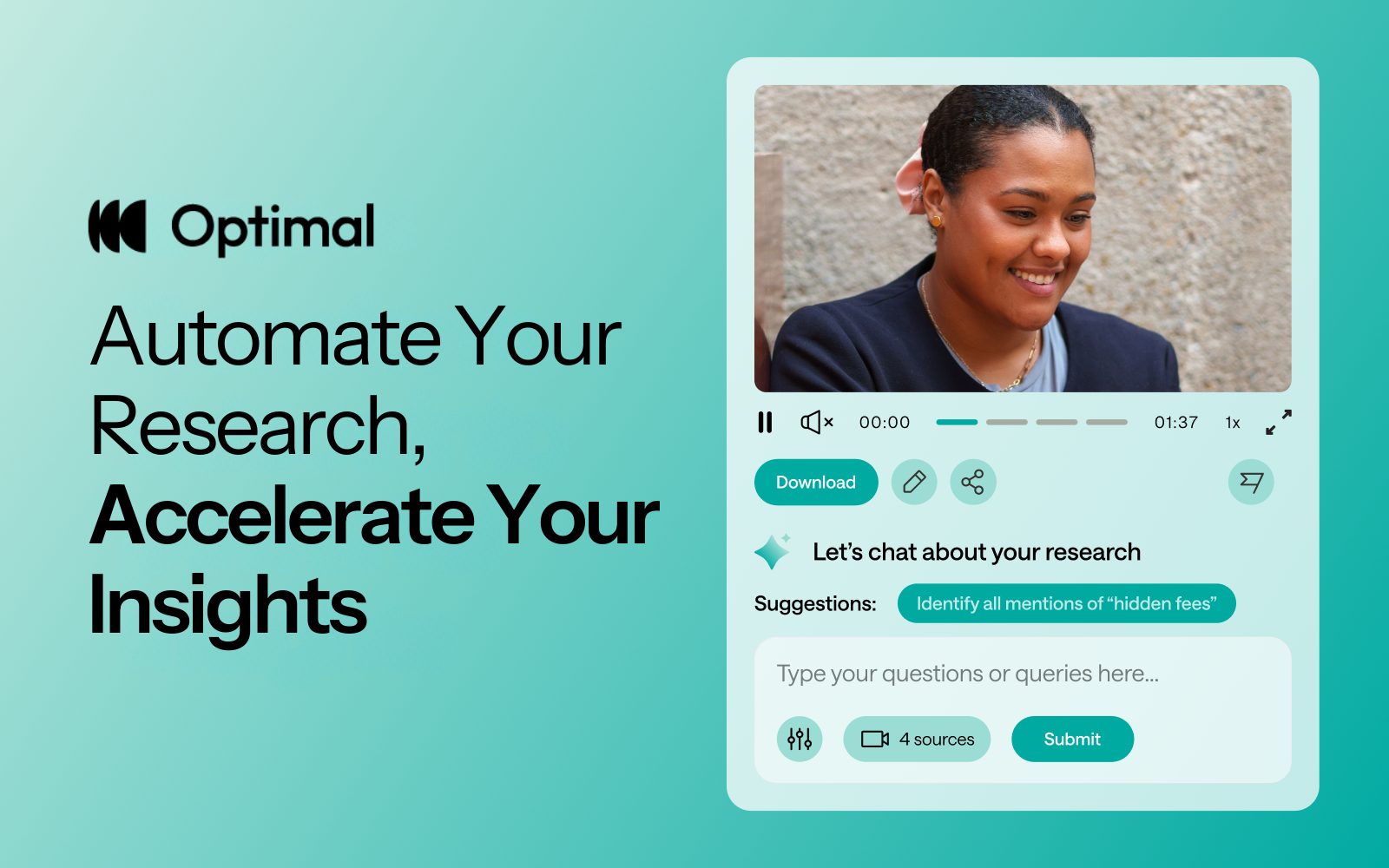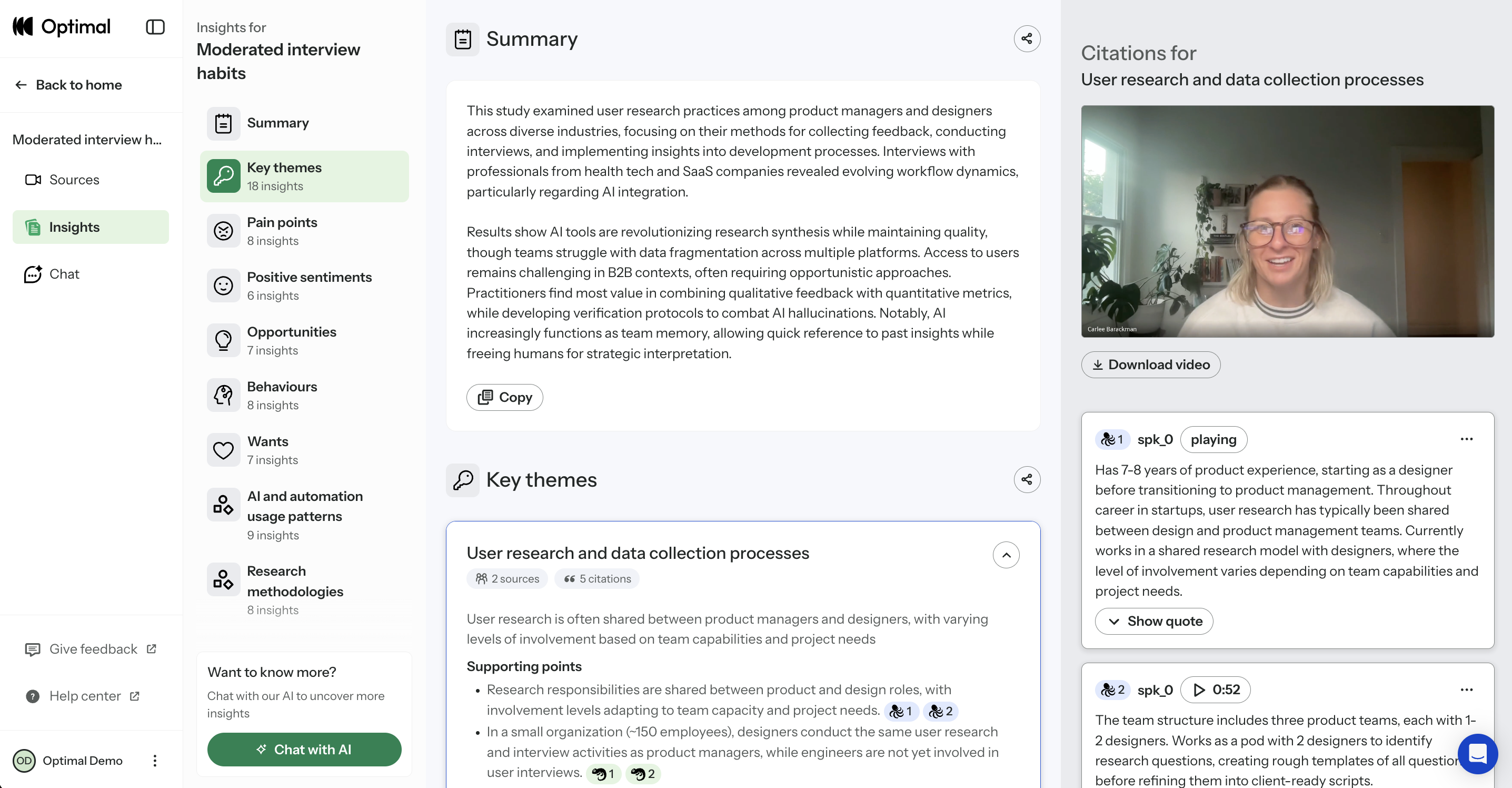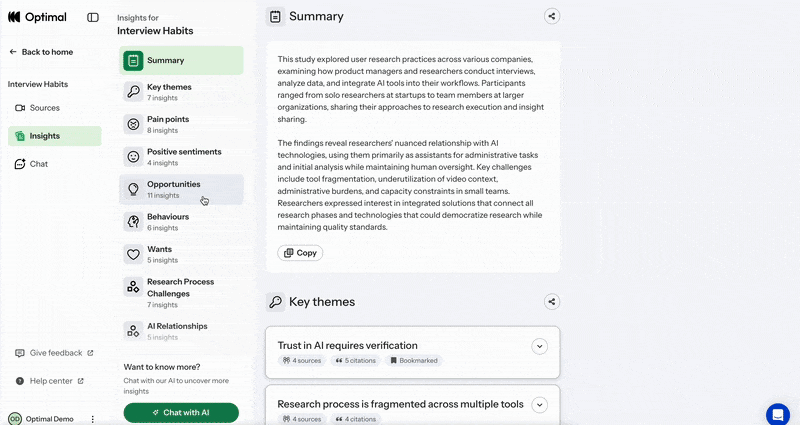Optimal Blog
Articles and Podcasts on Customer Service, AI and Automation, Product, and more

At Optimal, we know the reality of user research: you've just wrapped up a fantastic interview session, your head is buzzing with insights, and then... you're staring at hours of video footage that somehow needs to become actionable recommendations for your team.
User interviews and usability sessions are treasure troves of insight, but the reality is reviewing hours of raw footage can be time-consuming, tedious, and easy to overlook important details. Too often, valuable user stories never make it past the recording stage.
That's why we’re excited to announce the launch of early access for Interviews, a brand-new tool that saves you time with AI and automation, turns real user moments into actionable recommendations, and provides the evidence you need to shape decisions, bring stakeholders on board, and inspire action.
Interviews, Reimagined
What once took hours of video review now takes minutes. With Interviews, you get:
- Instant clarity: Upload your interviews and let AI automatically surface key themes, pain points, opportunities, and other key insights.
- Deeper exploration: Ask follow-up questions and anything with AI chat. Every insight comes with supporting video evidence, so you can back up recommendations with real user feedback.
- Automatic highlight reels: Generate clips and compilations that spotlight the takeaways that matter.
- Real user voices: Turn insight into impact with user feedback clips and videos. Share insights and download clips to drive product and stakeholder decisions.

Groundbreaking AI at Your Service
This tool is powered by AI designed for researchers, product owners, and designers. This isn’t just transcription or summarization, it’s intelligence tailored to surface the insights that matter most. It’s like having a personal AI research assistant, accelerating analysis and automating your workflow without compromising quality. No more endless footage scrolling.
The AI used for Interviews as well as all other AI with Optimal is backed by AWS Amazon Bedrock, ensuring that your AI insights are supported with industry-leading protection and compliance.

What’s Next: The Future of Moderated Interviews in Optimal
This new tool is just the beginning. Soon, you’ll be able to manage the entire moderated interview process inside Optimal, from recruitment to scheduling to analysis and sharing.
Here’s what’s coming:
- Recruit users using Optimal’s managed recruitment services.
- View your scheduled sessions directly within Optimal. Link up with your own calendar.
- Connect seamlessly with Zoom, Google Meet, or Teams.
Imagine running your full end-to-end interview workflow, all in one platform. That’s where we’re heading, and Interviews is our first step.
Ready to Explore?
Interviews is available now for our latest Optimal plans with study limits. Start transforming your footage into minutes of clarity and bring your users’ voices to the center of every decision. We can’t wait to see what you uncover.
Want to learn more and see it in action? Join us for our upcoming webinar on Oct 21st at 12 PM PST.
Topics
Research Methods
Popular
All topics
Latest

The Insight to Roadmap Gap
Why Your Best Insights Never Make It Into Products
Does this sound familiar? Your research teams spend weeks uncovering user insights. Your Product teams spend months building features users don't want. Between these two realities lies one of the most expensive problems in product development.
According to a 2024 Forrester study, 73% of product decisions are made without any customer insight, despite 89% of companies investing in user research. This is not because of a lack of research, but instead because of a broken translation process between discovery and delivery.
This gap isn't just about communication, it's structural. Researchers speak in themes, patterns, and user needs. Product managers speak in features, priorities, and business outcomes. Designers speak in experiences and interfaces. Each discipline has its own language, timelines, and success metrics.
The biggest challenge isn't conducting research, it's making sure that research actually influences what gets built.
Why Good Research Dies in Translation:
- Research operates in 2-4 week cycles. Product decisions happen in real-time. By the time findings are synthesized and presented, the moment for influence has passed.
- A 40-slide research report is nobody's idea of actionable. According to Nielsen Norman Group research, product managers spend an average of 12 minutes reviewing research findings, yet the average research report takes 2 hours to fully digest.
- Individual insights lack context. Was this problem mentioned by 1 user or 20? Is it a dealbreaker or a minor annoyance? Without this context, teams can't prioritize effectively.
The most successful product teams don't just conduct research, they create processes and systems that bridge the gap between research and product including doing more continuous discovery and connecting research insights into actual product updates.
- Teams doing continuous discovery make 3x more research-informed decisions than those doing quarterly research sprints. This becomes more achievable when the entire product trio (PM, designer, researcher) is involved in ongoing discovery.
- Product and research teams need to work together to connect research insights directly to potential features. Mapping each insight to product opportunities, which map to experiments, which feed directly into the roadmap.
Recent research from Stanford's Human-Centered AI Institute revealed that AI-driven interfaces created 2.6 times more usability issues for older adults and 3.2 times more issues for users with disabilities compared to general populations, a gap that often goes undetected without specific testing for these groups.
The Optimal Approach: Design with Evidence, Not Assumptions
The future of product development isn't just about doing more continuous research, it's about making research integral to how decisions happen:
- Start with Questions, Not Studies. Before launching research, collaborate with product teams to identify specific decisions that need informing. What will change based on what you learn?
- Embed Researchers in Roadmap Planning. Research findings should be part of sprint planning, roadmap reviews, and OKR setting.
- Measure Research Impact.: Track not just what research you do, but what decisions it influences. Amplitude found that teams measuring "research-informed feature success rate" show 35% higher user satisfaction scores.
The question you need to ask your organization isn't whether your research is good enough. It's whether your research to product collaboration process is strong enough to ensure those insights actually shape what gets built.
.png)
The AI Automation Breakthrough: Key Insights from Our Latest Community Event
Last night, Optimal brought together an incredible community of product leaders and innovators for "The Automation Breakthrough: Workflows for the AI Era" at Q-Branch in Austin, Texas. This two-hour in-person event featured expert perspectives on how AI and automation are transforming the way we work, create, and lead.
The event featured a lightning Talk on "Designing for Interfaces" featured Cindy Brummer, Founder of Standard Beagle Studio, followed by a dynamic panel discussion titled "The Automation Breakthrough" with industry leaders including Joe Meersman (Managing Partner, Gyroscope AI), Carmen Broomes (Head of UX, Handshake), Kasey Randall (Product Design Lead, Posh AI), and Prateek Khare (Head of Product, Amazon). We also had a fireside chat with our CEO, Alex Burke and Stu Smith, Head of Design at Atlassian.
Here are the key themes and insights that emerged from these conversations:
Trust & Transparency: The Foundation of AI Adoption
Cindy emphasized that trust and transparency aren't just nice-to-haves in the AI era, they're essential. As AI tools become more integrated into our workflows, building systems that users can understand and rely on becomes paramount. This theme set the tone for the entire event, reminding us that technological advancement must go hand-in-hand with ethical considerations.
Automation Liberates Us from Grunt Work
One of the most resonant themes was how AI fundamentally changes what we spend our time on. As Carmen noted, AI reduces the grunt work and tasks we don't want to do, freeing us to focus on what matters most. This isn't about replacing human workers, it's about eliminating the tedious, repetitive tasks that drain our energy and creativity.
Enabling Creativity and Higher-Quality Decision-Making
When automation handles the mundane, something remarkable happens: we gain space for deeper thinking and creativity. The panelists shared powerful examples of this transformation:
Carmen described how AI and workflows help teams get to insights and execution on a much faster scale, rather than drowning in comments and documentation. Prateek encouraged the audience to use automation to get creative about their work, while Kasey shared how AI and automation have helped him develop different approaches to coaching, mentorship, and problem-solving, ultimately helping him grow as a leader.
The decision-making benefits were particularly striking. Prateek explained how AI and automation have helped him be more thoughtful about decisions and make higher-quality choices, while Kasey echoed that these tools have helped him be more creative and deliberate in his approach.
Democratizing Product Development
Perhaps the most exciting shift discussed was how AI is leveling the playing field across organizations. Carmen emphasized the importance of anyone, regardless of their role, being able to get close to their customers. This democratization means that everyone can get involved in UX, think through user needs, and consider the best experience.
The panel explored how roles are blurring in productive ways. Kasey noted that "we're all becoming product builders" and that product managers are becoming more central to conversations. Prateek predicted that teams are going to get smaller and achieve more with less as these tools become more accessible.
Automation also plays a crucial role in iteration, helping teams incorporate customer feedback more effectively, according to Prateek.
Practical Advice for Navigating the AI Era
The panelists didn't just share lofty visions, they offered concrete guidance for professionals navigating this transformation:
Stay perpetually curious. Prateek warned that no acquired knowledge will stay with you for long, so you need to be ready to learn anything at any time.
Embrace experimentation. "Allow your process to misbehave," Prateek advised, encouraging attendees to break from rigid workflows and explore new approaches.
Overcome fear. Carmen urged the audience not to be afraid of bringing in new tools or worrying that AI will take their jobs. The technology is here to augment, not replace.
Just start. Kasey's advice was refreshingly simple: "Just start and do it again." Whether you're experimenting with AI tools or trying "vibe coding," the key is to begin and iterate.
The energy in the room at Q-Branch reflected a community that's not just adapting to change but actively shaping it. The automation breakthrough isn't just about new tools, it's about reimagining how we work, who gets to participate in product development, and what becomes possible when we free ourselves from repetitive tasks.
As we continue to navigate the AI era, events like this remind us that the most valuable insights come from bringing diverse perspectives together. The conversation doesn't end here, it's just beginning.
Interested in joining future Optimal community events? Stay tuned for upcoming gatherings where we'll continue exploring the intersection of design, product, and emerging technologies.

Reimagining User Interviews for the Modern Product Workflow
When we planned our product roadmap for 2025 we talked to our users to understand their biggest pain points and one thing came up time and time again: conducting and analyzing user interviews, while still one of the most important aspects of user research, was still incredibly painful and time consuming.
So we went away, and we tried to envision the perfect workflow for user interviews for product, design and research terms and what we came up with looked a little something like this:
- Upload a video, and within minutes, key insights surface automatically
- Ask questions and get back evidence with video citations
- Create video highlight reals faster than ever for shareable insights
- User voices reach product decisions and executive teams in time to influencer product decisions
Then we went and built it.
Interviews, Reimagined
Traditional interviews are passive. They sit in folders, waiting for someone to have time to review them. But what if interviews could speak for themselves? What if they could surface their own insights, highlight critical moments, and answer follow-up questions?
This isn't science fiction, it's the natural evolution of user research, powered by AI (and built by Optimal).
Most research teams have folders full of unanalyzed video content and hours of valuable insights buried in hours of footage and unfortunately, talking to your users doesn't matter if insights never surface. Most research teams area already trying to leverage AI for solve some of their challenges, but generic AI tools miss the nuance of user research. They can transcribe words but can't identify pain points. They can find keywords but can't surface behavioral patterns. They understand language but not user psychology. The next generation of user interview tools require research-grade AI. AI trained on user research methodologies. Algorithms that understand the difference between stated preferences and actual behavior. Technology that recognizes emotional cues, identifies friction points, and connects user needs to product opportunities.
Traditional analysis creates static reports. Product, design and research teams need tools for user interviews that create dynamic intelligence. Instead of documents that get filed away, imagine insights that flow directly into product decisions:
- Automatic highlight reels that bring user voices to stakeholder meetings
- Evidence-backed recommendations with supporting video clips
- Searchable repositories where any team member can ask questions and get answers
- Real-time insight sharing that influences decisions while they're being made
Manual analysis can take weeks or even months, especially for large datasets. AI-powered tools can speed this process up significantly, but time savings is just the beginning. The real transformation happens when researchers stop spending time on manual tasks and start spending time on strategic thinking. When analysis happens automatically, human intelligence can focus on synthesis, strategy, and storytelling.
We are reimagining user interviews from the ground up. Instead of weeks of manual analysis we want you to be able to surface insights in hours. Instead of static reports, we want you to have dynamic, searchable intelligence. Instead of user voices lost in transcripts, we want to help you get video evidence that influences every product decision.
This isn't a distant future, it's happening now. We can’t wait for you to see it.

Beyond Compliance: Making Airline Accessibility a Competitive Advantage
In the aviation industry, accessibility has traditionally been viewed through the narrow lens of regulatory compliance, something to be addressed primarily to avoid penalties and litigation. This limited perspective misses the broader opportunity: creating truly inclusive travel experiences doesn't just serve passengers with disabilities, it delivers better experiences for everyone and creates meaningful competitive differentiation.
The Business Case for Airline Accessibility
The numbers alone make a compelling case for prioritizing accessibility:
- Over 1 billion people worldwide, approximately 15% of the global population, live with some form of disability according to the World Health Organization
- Passengers with disabilities often travel with companions, multiplying the economic impact of their travel decisions
- The global accessible travel market is valued at approximately $70 billion annually with consistent growth outpacing general travel market growth
But beyond the direct market size, accessibility investments deliver broader benefits:
- Improved Experiences for All Passengers: Many accessibility improvements, like clearer communication, simpler interfaces, and more flexible service options that benefit every traveler
- Enhanced Brand Perception: Airlines recognized for inclusive practices enjoy improved reputation among all customer segments
- Reduced Legal and Regulatory Risk: Proactive accessibility programs minimize exposure to increasing global regulations
- Operational Efficiencies: Well-designed accessible services often require less special handling and exception processing
The Accessible Journey: Key Touchpoints for Improvement
Digital Experience: Beyond WCAG Compliance
While Web Content Accessibility Guidelines (WCAG) provide a crucial foundation, truly excellent digital accessibility goes further:
Booking Flow Accessibility
Current Challenge: Many airline booking engines remain technically accessible but practically difficult for users with disabilities, particularly on mobile devices.
Opportunity: Design booking experiences with accessibility as a core principle rather than a compliance afterthought:
- Ensure screen reader compatibility across all booking steps
- Implement keyboard navigation that works logically within complex forms
- Provide alternative text methods for selecting seats traditionally done through visual seat maps
- Design with sufficient color contrast and flexibility for text resizing
Going Beyond Compliance: A European low-cost carrier redesigned their entire booking flow based on inclusive design principles, resulting in a 23% increase in mobile conversion rates for all customers. not just those with disabilities.
Service Continuity: The Accessible Journey
Current Challenge: Accessibility information often doesn't transition effectively between booking, airport, and in-flight experiences, forcing passengers to repeatedly communicate needs.
Opportunity: Create continuity of accessible service across the entire journey:
- Develop persistent accessibility profiles that travel with the passenger's reservation
- Implement seamless handoffs between digital and human touchpoints
- Design proactive service recovery specifically for passengers with accessibility needs
Going Beyond Compliance: One major U.S. carrier implemented an accessibility journey management system that alerts staff at connection points about incoming passengers with special requirements, eliminating the need for passengers to repeatedly explain their needs.
In-Flight Experience: Inclusive by Design
Current Challenge: Aircraft cabin environments present inherent accessibility challenges, from lavatory access to entertainment systems.
Opportunity: Design cabin experiences with accessibility as a core consideration:
- Implement accessible in-flight entertainment with closed captioning, audio description, and interface accessibility
- Train cabin crew specifically on disability etiquette and assistance techniques
- Redesign service elements like meal options and call buttons for universal use
Going Beyond Compliance: A Middle Eastern airline redesigned their in-flight entertainment system with comprehensive accessibility features and found that usage increased among all passengers, not just those with disabilities.
Implementing Effective Accessibility Programs
1. Shift from Reactive to Proactive
Most airlines still operate in a reactive model, addressing accessibility issues as they arise through special assistance requests and exception handling.
The Proactive Alternative:
- Conduct comprehensive accessibility audits across all customer touchpoints
- Implement accessibility testing as a standard part of all digital and service releases
- Establish an accessibility steering committee with executive sponsorship
- Include people with disabilities in your design and testing processes
2. Broaden Your Accessibility Perspective
Accessibility isn't just about wheelchair users, it encompasses a wide spectrum of needs:
- Mobility Impairments: From wheelchair users to those who can walk but have difficulty with distances or stairs
- Visual Impairments: From total blindness to low vision and color blindness
- Hearing Impairments: From profound deafness to partial hearing loss
- Cognitive Disabilities: Including learning disabilities, attention disorders, and memory impairments
- Invisible Disabilities: Including chronic pain conditions, fatigue disorders, and mental health conditions
Each category requires specific considerations in experience design. An American carrier lost a major discrimination lawsuit because they designed their accessibility program primarily around wheelchair users while neglecting the needs of deaf passengers.
3. Invest in Staff Training
The human element remains crucial for accessible travel experiences:
- Develop comprehensive accessibility training programs for customer-facing staff
- Create specialized training modules for specific roles (reservations, gate agents, flight attendants)
- Include disability etiquette alongside technical procedures
- Have people with disabilities participate in training development and delivery
One Scandinavian airline saw customer complaints from passengers with disabilities drop by 40% after implementing a comprehensive staff training program focused on disability confidence rather than just procedural compliance.
4. Leverage Technology as an Accessibility Enabler
New technologies create opportunities for significantly improved accessibility:
- Mobile Wayfinding: Indoor navigation applications to help visually impaired travelers navigate terminals
- Remote Assistance: Video-based applications connecting staff with specialized training to any airport location
- Wearable Technology: Alert systems that can notify deaf travelers about announcements through vibration and text
- Voice Interfaces: Enabling hands-free interaction with airline systems for mobility-impaired travelers
Measuring Accessibility Success
Effective accessibility programs require specific measurement frameworks:
- Accessibility Audit Scores: Regular technical evaluations of digital properties against WCAG standards
- Inclusive Customer Metrics: Satisfaction scores specifically from passengers with disabilities
- Assistance Request Trends: Monitoring changes in special assistance requests
- Complaint Analysis: Detailed tracking of accessibility-related complaints
- Operational Metrics: Time and resources required to provide accessible services
Regulatory Landscape: Preparing for Increased Scrutiny
The regulatory environment for airline accessibility continues to evolve:
- The Air Carrier Access Act (ACAA) in the U.S. continues to expand in scope
- The European Accessibility Act introduces new digital accessibility requirements
- Global standards are gradually harmonizing, though significant regional variations remain
Rather than approaching these as compliance hurdles, forward-thinking airlines are using regulatory changes as catalysts for comprehensive accessibility improvements.
Using Optimal to Advance Accessibility Initiatives
Creating truly accessible airline experiences requires systematic research with diverse user groups. Optimal's platform offers specialized tools that can significantly enhance accessibility initiatives:
Accessibility-Focused User Testing
Optimal's research tools can be specifically configured to evaluate experiences for passengers with disabilities:
Treejack for Navigation Accessibility
- Test how effectively screen reader users can navigate your digital booking flows
- Compare task completion rates between users with and without disabilities
- Identify navigation structures that work universally across different ability levels
Application Example: An international carrier discovered through Treejack testing that their multi-level navigation structure was creating significant barriers for screen reader users, leading to a navigation redesign that improved task completion rates by 62% for vision-impaired users.
First-Click Testing for Interface Accessibility
Identifying where the accessibility journey breaks down is crucial for improvement:
- Test critical first interactions across different assistive technologies
- Compare success rates between standard and accessible interfaces
- Validate that accessibility improvements don't negatively impact mainstream users
Application Example: Through first-click testing with mobility-impaired users, a European airline identified that their seat selection interface required significant dexterity, leading to a redesign that improved completion rates for all users.
Comprehensive Accessibility Audits
Optimal's research repository allows airlines to create comprehensive accessibility knowledge bases:
- Document accessibility findings across multiple research studies
- Create accessibility personas representing different disability types
- Track accessibility improvements over time with consistent metrics
Implementation Strategy: One major airline created a dedicated accessibility research panel within Optimal, recruiting passengers with various disabilities for ongoing testing. This approach enabled them to conduct rapid, iterative testing of accessibility improvements rather than relying on annual major audits.
Remote Moderated Testing with Diverse Participants
Optimal's remote testing capabilities enable research with geographically dispersed participants using various assistive technologies:
- Conduct studies with participants using their own assistive technology setup
- Observe real-world usage patterns across different disability types
- Gather insights from participants in different regions with varying accessibility needs
Application Example: A global airline alliance used Optimal's remote testing capabilities to conduct simultaneous accessibility testing across multiple markets, identifying regional variations in accessibility expectations and requirements.
By incorporating Optimal's research tools into your accessibility program, you can move beyond compliance checklists to truly understand the lived experience of passengers with disabilities, creating air travel experiences that work for everyone.
Conclusion: From Accommodation to Inclusion
The future of airline accessibility isn't about special accommodations, it's about designing core experiences that work for everyone from the beginning. This shift from accommodation to inclusion represents not just a philosophical change but a practical approach that delivers better experiences while reducing operational complexity.
The airlines that distinguish themselves in the next decade won't just be those with the newest aircraft or the most extensive networks, they'll be those that make travel truly accessible to the broadest possible customer base. By embracing accessibility as a core design principle rather than a compliance requirement, you're not just doing the right thing, you're creating sustainable competitive advantage in an industry where differentiation is increasingly difficult to achieve.

Why Understanding Users Has Never Been Easier...or Harder
Product, design and research teams today are drowning in user data while starving for user understanding. Never before have teams had such access to user information, analytics dashboards, heatmaps, session recordings, survey responses, social media sentiment, support tickets, and endless behavioral data points. Yet despite this volume of data, teams consistently build features users don't want and miss needs hiding in plain sight.
It’s a true paradox for product, design and research teams: more information has made genuine understanding more elusive.
Because with all this data, teams feel informed. They can say with confidence: "Users spend 3.2 minutes on this page," "42% abandon at this step," "Power users click here." But what this data doesn't tell you is Why.
The Difference between Data and Insight
Data tells you what happened. Understanding tells you why it matters.
Here’s a good example of this: Your analytics show that 60% of users abandon a new feature after first use. You know they're leaving. You can see where they click before they go. You have their demographic data and behavioral patterns.
But you don't know:
- Were they confused or simply uninterested?
- Did it solve their problem too slowly or not at all?
- Would they return if one thing changed, or is the entire approach wrong?
- Are they your target users or the wrong segment entirely?
One team sees "60% abandonment" and adds onboarding tooltips. Another talks to users and discovers the feature solves the wrong problem entirely. Same data, completely different understanding.
Modern tools make it dangerously easy to mistake observation for comprehension, but some aspects of user experience exist beyond measurement:
- Emotional context, like the frustration of trying to complete a task while handling a crying baby, or the anxiety of making a financial decision without confidence.
- The unspoken needs of users which can only be demonstrated through real interactions. Users develop workarounds without reporting bugs. They live with friction because they don't know better solutions exist.
- Cultural nuances that numbers don't capture, like how language choice resonates differently across cultures, or how trust signals vary by context.
- Data shows what users do within your current product. It doesn't reveal what they'd do if you solved their problems differently to help you identify new opportunities.
Why Human Empathy is More Important than Ever
The teams building truly user-centered products haven't abandoned data but they've learned to combine quantitative and qualitative insights.
- Combine analytics (what happens), user interviews (why it happens), and observation (context in which it happens).
- Understanding builds over time. A single study provides a snapshot; continuous engagement reveals the movie.
- Use data to form theories, research to validate them, and real-world live testing to confirm understanding.
- Different team members see different aspects. Engineers notice system issues, designers spot usability gaps, PMs identify market fit, researchers uncover needs.
Adding AI into the mix also emphasizes the need for human validation. While AI can help significantly speed up workflows and can augment human expertise, it still requires oversight and review from real people.
AI can spot trends humans miss, processing millions of data points instantly but it can't understand human emotion, cultural context, or unspoken needs. It can summarize what users say but humans must interpret what they mean.
Understanding users has never been easier from a data perspective. We have tools our predecessors could only dream of. But understanding users has never been harder from an empathy perspective. The sheer volume of data available to us creates an illusion of knowledge that's more dangerous than ignorance.
The teams succeeding aren't choosing between data and empathy, they're investing equally in both. They use analytics to spot patterns and conversations to understand meaning. They measure behavior and observe context. They quantify outcomes and qualify experiences.
Because at the end of the day, you can track every click, measure every metric, and analyze every behavior, but until you understand why, you're just collecting data, not creating understanding.

Why User Interviews Haven't Evolved in 20 Years (And How We're Changing That)
Are we exaggerating when we say that the way the researchers run and analyze user interviews hasn’t changed in 20 years? We don’t think so. When we talk to our customers to try and understand their current workflows, they look exactly the same as they did when we started this business 17 years ago: record, transcribe, analyze manually, create reports. See the problem?
Despite advances in technology across every industry, the fundamental process of conducting and analyzing user interviews has remained largely unchanged. While we've transformed how we design, develop, and deploy products, the way we understand our users is still trapped in workflows that would feel familiar to product, design and research teams from decades ago.
The Same Old Interview Analysis Workflow
For most researchers, in the best case scenario, Interview analysis can take several hours over the span of multiple days. Yet in that same timeframe, in part thanks to new and emerging AI tools, an engineering team can design, build, test, and deploy new features. That just doesn't make sense.
The problem isn't that researchers lack tools. It's that they haven’t had the right ones. Most tools focus on transcription and storage, treating interviews like static documents rather than dynamic sources of intelligence. Testing with just 5 users can uncover 85% of usability problems, yet most teams struggle to complete even basic analysis in time to influence product decisions. Luckily, things are finally starting to change.
When it comes to user research, three things are happening in the industry right now that are forcing a transformation:
- The rise of AI means UX research matters more than ever. With AI accelerating product development cycles, the cost of building the wrong thing has never been higher. Companies that invest in UX early cut development time by 33-50%, and with AI, that advantage compounds exponentially.
- We're drowning in data and have fewer resources. We’re seeing the need for UX research increase, while simultaneously UX research teams are more resource constrained than ever. Tasks like analyzing hours of video content to gather insights, just isn’t something teams have time for anymore.
- AI finally understands research. AI has evolved to a place where it can actually provide valuable insights. Not just transcription. Real research intelligence that recognizes patterns, emotions, and the gap between what users say and what they actually mean.
A Dirty Little Research Secret + A Solution
We’re just going to say it; most user insights from interviews never make it past the recording stage. When it comes to talking to users, the vast majority of researchers in our audience talk about recruiting pain because the most commonly discussed challenge around interviews is usually finding enough participants who match their criteria. But on top of the challenge of finding the right people to talk to, there’s another challenge that’s even worse: finding time to analyze what users tell us. But, what if you had a tool where using AI, the moment you uploaded an interview video, key themes, pain points, and opportunities surfaced automatically? What if you could ask your interview footage questions and get back evidence-based answers with video citations?
This isn't about replacing human expertise, it's about augmenting it. AI-powered tools can process and categorize data within hours or days, significantly reducing workload. But more importantly, they can surface patterns and connections that human analysts might miss when rushing through analysis under deadline pressure. Thanks to AI, we're witnessing the beginning of a research renaissance and a big part of that is reimagining the way we do user interviews.
Why AI for User Interviews is a Game Changer
When interview analysis accelerates from weeks to hours, everything changes.
Product teams can validate ideas before building them. Design teams can test concepts in real-time. Engineering teams can prioritize features based on actual user need, not assumptions. Product, Design and Research teams who embrace AI to help with these workflows, will be surfacing insights, generating evidence-backed recommendations, and influencing product decisions at the speed of thought.
We know that 32% of all customers would stop doing business with a brand they loved after one bad experience. Talking to your users more often makes it possible to prevent these experiences by acting on user feedback before problems become critical. When every user insight comes with video evidence, when every recommendation links to supporting clips, when every user story includes the actual user telling it, research stops being opinion and becomes impossible to ignore. When you can more easily gather, analyze and share the content from user interviews those real user voices start to get referenced in executive meetings. Product decisions begin to include user clips. Engineering sprints start to reference actual user needs. Marketing messages reflect real user voices and language.
The best product, design and research teams are already looking for tools that can support this transformation. They know that when interviews become intelligent, the entire organization becomes more user-centric. At Optimal, we're focused on improving the traditional user interviews workflow by incorporating revolutionary AI features into our tools. Stay tuned for exciting updates on how we're reimagining user interviews.
No results found.

